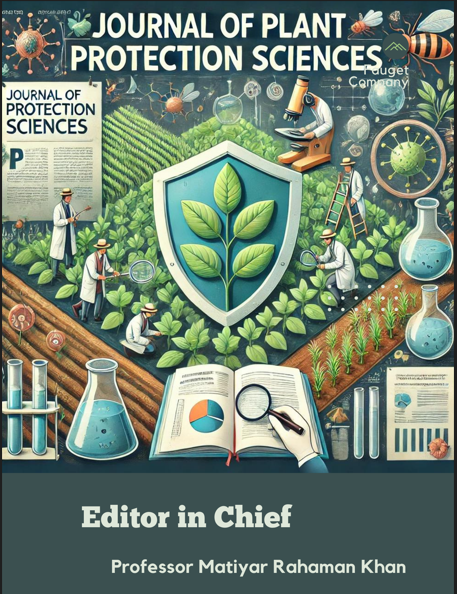Effect of dates of sowing, moisture regimes, varieties and weather factors on incidences of aphid, Lipaphis erysimi (Kalt.) in rape and mustard
DOI:
https://doi.org/10.48165/Keywords:
Aphid, sowing date, moisture regime, weather parameters, correlation, regressionAbstract
Mustard aphid which is influenced by predisposing abiotic factors, has been widely reported as the most noxious insect pest limiting production of rape and mustard. Field experiment was carried out with 3 varieties of rape and mustard, 6 dates of sowing and 2 moisture regimes to understand aphid population dynamics during different phases of growth of rainfed vis-à-vis irrigated rape and mustard crops, and work out relationships between aphid population and weather parameters for its forewarning. Results revealed that initial incidence times of aphid varied from 19 November to 3 December, depending upon dates of sowing done during 1 October to 5 November, which fall under recommended dates of sowing. In crops sown during 22 October to 5 November, critical periods of aphid infestation (having greater than 30 -1 -1 aphids plant ) prevailed between 19 December and 21 January. Number of aphids plant was consistently greater in crops grown under irrigated condition than those under rainfed condition.
References
Anonymous (2007). Estimates of area and production of principal crops in West Bengal, 2005-06. Directorate of Agriculture, Government of West Bengal, Kolkata, 164 pp.
Biswas, G.C. & Das, G.P. (2000). Population dynamics of the mustard aphid, Lipaphis erysimi (Kalt.) (Homoptera: Aphididae) in relation to weather parameters. Bangladesh Journal of Entomology, 10, 15-22.
Brar, N.S., Bakhetia, D.R.C., & Sekhon, B.S. (1987). Estimation of losses in yield of rapeseed and mustard due to mustard aphid, Lipaphis erysimi (Kalt.). Journal of Oilseeds Research, 4, 261-264.
Dubey, V.K. & Yadu, Y.K. (1998). Determination of economic threshold level of aphid (Lipaphis erysimi Kalt.) on mustard crop. Journal of Soils and Crops, 8, 1213-1226.
Gami, L.M., Bapodra, J.G., & Rathod, R.R. (2002). Population dynamics of mustard aphid [Lipaphis erysimi (Kaltenbach)] in relation to weather parameters. Indian Journal of Plant Protection, 30, 202-204.
Ghosh, R.K. & Chatterjee, B.N. (1988). Effect of date of sowing on the productivity of Indian mustard (Brassica juncea sub sp. juncea) in the short and mild winter of the Gangetic plains of West Bengal. Indian Journal of Agricultural Sciences, 58, 589-596.
Ghosh, M.R. (1993). Aphid Ba Jabpoka. West Bengal State Book Board, Kolkata, 175 pp.
Kalra, V.K., Singh, H., & Rohilla, H.R. (1987). Influence of various genotypes of Brassica on the biology of mustard aphid, Lipaphis erysimi (Kalt.). Indian Journal of Agricultural Sciences, 57, 277-279.
Kar, G. & Chakravarty, N.V.K. (2000). Predicting crop growth and aphid incidence in Brassica under semi-arid environment. Indian Journal of Agricultural Sciences, 70, 3-7.
Laskar, N., Mandal, J., & Ghosh, S.K. (2004). Effect of temperature on the incidence of mustard aphid, Lipaphis erysimi Kalt. on broccoli both in open and covered conditions in the Hills of Darjeeling. Environment and Ecology, 22, 342-344.
Nath, D.K. (1982). Review on control of mustard aphid, Lipaphis erysimi (Kalt.) (Aphididae: Homoptera) in India, pp. 207-213. In Pulses and Oilseeds in West Bengal (Ed. Mukherji, D.K.). Directorate of Agriculture, Government of West Bengal, Writers' Buildings, Kolkata, 223 pp.
Patel, I.G. & Mehta, A.N. (1987). Assessment of growth and yield of mustard (Brassica juncea (L.) Czern & Coss) in relation to heat units. International Journal of Ecology and Environmental Science, 13, 145-155.
Prasad, S.K. (2003). Studies on population dynamics of mustard aphid, Lipaphis erysimi on mustard in relation to some meteorological factors. Indian Journal of Entomology, 65, 569-578.
Prasad, S.K. & Pradhan, S. (1971). Distribution and sampling of mustard aphid, Lipaphis pseudobrassicae (Davis). Indian Journal of Entomology, 33, 260-271.
Prasad, S.K. & Phadke, K.G. (1980). Population dynamics of Lipaphis erysimi (Kalt.) on different varieties of Brassica species. Indian Journal of Entomology, 42, 54-63.
Ring, D.R., Calcote, V.R., & Harris, M.K. (1983). Verification and generalization of a degree-day model predicting pecan nut case bearer (Lepidoptera: Pyralidae) activity. Environmental Entomology, 12, 487-489.
Roy, S.K. & Baral, K. (2002). Role of weather parameters on population build-up of mustard aphid, Lipaphis erysimi (Kaltenbach). Journal of Oilseeds Research, 19, 86-89.
Singh, S.S. & Lal, M.N. (1999). Seasonal incidence of mustard aphid, Lipaphis erysimi (Kalt.) on mustard crop. Journal of Entomological Research, 23, 165-167.
Singh, C.P. & Sachan, G.C. (1994). Assessment of yield losses in yellow sarson due to mustard aphid, Lipaphis erysimi (Kalt.). Journal of Oilseeds Research, 11, 179-184.
Singh, N.N., Prasad, M.N., & Rai, V.N. (1989). Population fluctuation of Lipaphis erysimi (Kaltenbach) in relation to abiotic factors. Journal of Aphidology, 3, 102-108.
Upadhyay, S. (1996). Influence of sowing dates and fertilizer level on the incidence of aphid (Lipaphis erysimi Kalt.) on Indian mustard. Indian Journal of Entomology, 57, 294-297.

